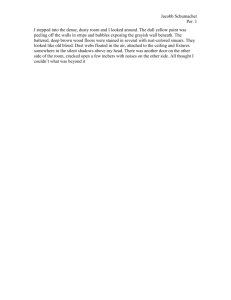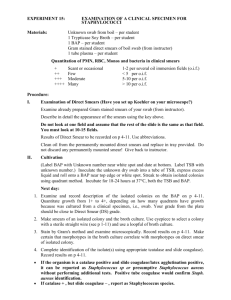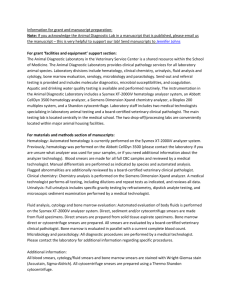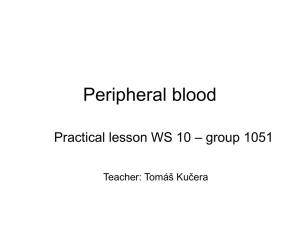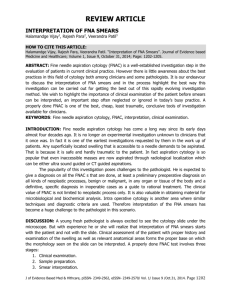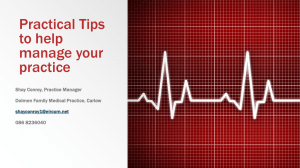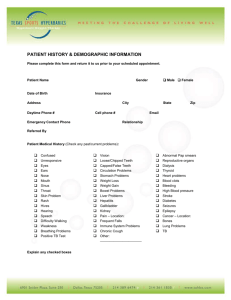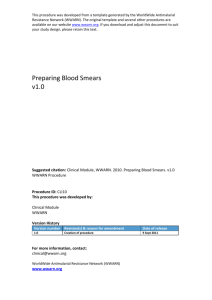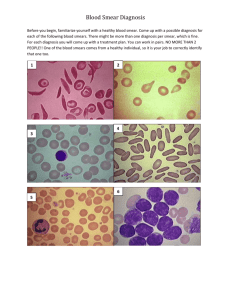7.2.2 Supervision Comprehensive checklist
advertisement
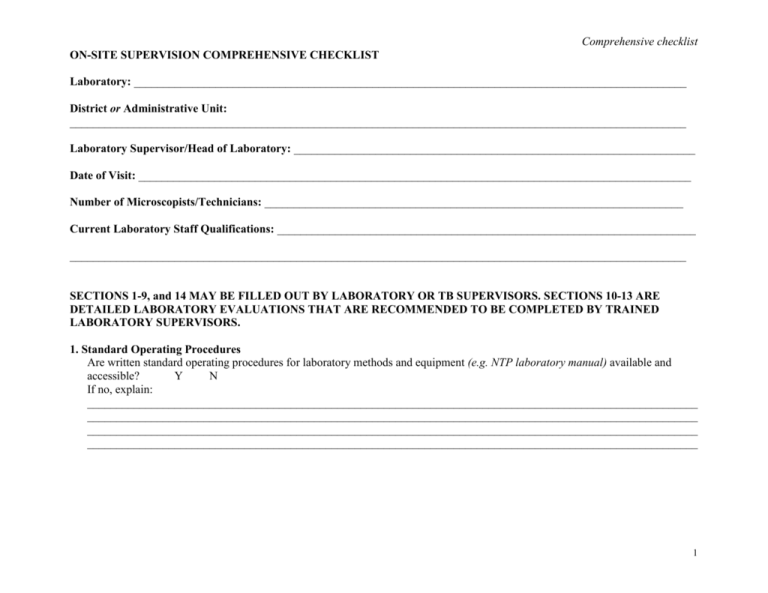
Comprehensive checklist ON-SITE SUPERVISION COMPREHENSIVE CHECKLIST Laboratory: _______________________________________________________________________________________________ District or Administrative Unit: __________________________________________________________________________________________________________ Laboratory Supervisor/Head of Laboratory: _____________________________________________________________________ Date of Visit: _______________________________________________________________________________________________ Number of Microscopists/Technicians: ________________________________________________________________________ Current Laboratory Staff Qualifications: ________________________________________________________________________ __________________________________________________________________________________________________________ SECTIONS 1-9, and 14 MAY BE FILLED OUT BY LABORATORY OR TB SUPERVISORS. SECTIONS 10-13 ARE DETAILED LABORATORY EVALUATIONS THAT ARE RECOMMENDED TO BE COMPLETED BY TRAINED LABORATORY SUPERVISORS. 1. Standard Operating Procedures Are written standard operating procedures for laboratory methods and equipment (e.g. NTP laboratory manual) available and accessible? Y N If no, explain: _________________________________________________________________________________________________________ _________________________________________________________________________________________________________ _________________________________________________________________________________________________________ _________________________________________________________________________________________________________ 1 Comprehensive checklist 2. Laboratory Reagents Observe and Question Are all staining reagents available? Indicator Reagent Available Observe storage conditions.1 Have there been any shortages of reagents within the last three months? (*Adequate supply is defined as available current supply and no shortages over the past three months)2. Observe that all reagents in use are within expiration date. Observe that immersion oil has acceptable viscosity (not too thick or too thin)3. Within expiration date Y N carbol fuchsin Y N methylene blue Y N Y sulphuricacid 25% Or acid alcohol 3% immersion oil Y N Y xylene Y Adequate Supply* Y N N Y N Y N Y N N Y N Y N N Y N Y N Explain any problems or deficiencies ____________________________________________________________________________________________________________ ____________________________________________________________________________________________________________ ____________________________________________________________________________________________________________ Action Required ______________________________________________________________________________________________ 1 Stains should be protected from sunlight (to be stored in brown bottles).All bottles and fluids should be closed tightly. Adequate quantities should be available for 3-6 months. If properly prepared, stains can be stored for at least 12 months but not more that 2 years. Count the number of examinations over the last12 months, and calculate monthly average. There should be at least 3L of carbol fuchsin or methylene blue and 6L acid solution per 1000 smears. 3 Required volume of immersion oil: 1ml per 10-20 smears or 50-100ml per 1000 smears. 2 2 Comprehensive checklist 3. Laboratory Supplies Observe and Question Are the following items available? Is the type of sputum containers in use approved by the NTP? Check to determine that slide boxes are of adequate design (slides are stored standing up to drain oil and without touching each other) and number (sufficient boxes to store the number of slides required for adequate sampling)4. Have there been any shortages of supplies within the past three months? (*Adequate supply is defined as available current supply and no shortages over the past three months).5 A clean water supply should be available; distilled water is recommended. Water should be stored in bottles free of environmental contaminants including bacteria and fungus. Water from stagnant containers should not be used. If stains are prepared at the laboratory, consider availability of a measuring cylinder, glassware, balance. For preparation of stains, purified water is an absolute minimum. Indicator Material slides frosted slides slide boxes sputum containers approved by NTP diamond pencil (or) pencils (use with frosted slides) or slide markers6 (if no frosted slides) wire loops or sticks funnel filter paper staining racks spirit lamp or Bunsen burner fuel for spirit lamp7 or gas for burner lens tissue red pen for recording positive results water supply balance (for weighing reagents) Available Y Y Y Y N N N N Y N Y Good Condition Adequate Supply * Y Y Y Y N N N N N Y N Y Y Y Y Y Y Y N N N N N N N Y Y Y N N N Y Y N N Y N Y N Y Y N N Y N Y Y N N Y N Y N Y N Y N Y N Y Y Y Y N N N N Explain any problems or deficiencies ____________________________________________________________________________________________________________ ____________________________________________________________________________________________________________ ____________________________________________________________________________________________________________ Action Required _____________________________________________________________________________________________ 4 The number of slide boxes should be sufficient to keep all slides for a sampling period (often one quarter), or 500 slides at a minimum. The required quantity of sputum containers and slides is 1100 per 1000 smears examined. 6 The number of inexpensive slide markers: is 1 marker per 500-1000 slides. 7 The required volume of the burning spirit: 1-2 L per 1000 smears. 5 3 Comprehensive checklist 4. Laboratory Safety Observe and Question Where is TB work performed? Does the laboratory have adequate ventilation? If smears are performed in front of an open window, are technicians aware of air flow direction and potential for danger? Which disinfectant is used? Have there been any shortages of disinfectant supply in the past three months? How often are work areas cleaned with disinfectant? How are wire loops cleaned? How are used slides disposed of? Are slides ever reused? How used sputum containers are disposed of? Are sputum containers ever reused? Observe biohazard waste bin. Are workers wearing lab coats? Are lab coats removed prior to leaving the laboratory? Are gloves used in the laboratory? Are they used properly? Do workers wash their hands after working with sputum? Does laboratory appear clean and in good working order? Indicator TB work is performed in an area separate from other laboratory procedures. There are separate tables for smear preparation and microscopy. There is adequate & safe ventilation. Y N Y N Y N An NTP approved disinfectant active against TB is used. An adequate supply of disinfectant is available. Y N Y N Work areas are cleaned at least daily. A sand bucket with lysol or 70% ethanol is used to clean wire loops prior to flaming. Used slides are properly disposed of (boiled or buried). If slides are reused, they are properly disinfected and cleaned, and never reused for AFB microscopy. Sputum containers are used only one time. Used containers are burned or properly buried8. A biohazard waste bin with a lid is available. Lab coats are worn while working in the laboratory. Lab coats are not worn outside the laboratory. If gloves are available, they are used in accordance with safe work practice recommendations. Proper handwashing procedures are followed. Laboratory is clean, layout is adequate to ensure safe practices Y Y N N Y N Y N Y Y Y Y Y Y N N N N N N Y Y N N Explain any problems or deficiencies ____________________________________________________________________________________________________________ Action required ______________________________________________________________________________________________ 8 The supervisor should check waste disposal site to ensure proper burial of waste. 4 Comprehensive checklist 5. Laboratory Request Form, Laboratory Register, Laboratory Reports Observe and Question Are the NTP approved laboratory request forms used for every patient? Are laboratory request forms submitted by clinicians with complete information? Is the laboratory register present, and all columns completed properly?9 Are patient records in laboratory register consistent with District Register?10 (Compare 10 patients from the laboratory register and determine if all 10 patients are listed in the district register) When is result information entered into the laboratory register?11 Are laboratory results recorded on the request form? How soon are results reported to the treatment center or physician? Indicator NTP approved laboratory request forms are used for every patient. Laboratory request forms are submitted with complete information. Laboratory register is present. Laboratory register is properly complete and legible. District TB cases appear in Laboratory register If no, how many patients are missing? ____________ Y N Y N Y Y Y N N N Results entered into register daily Y N Laboratory results are recorded directly onto the form. Forms are sent back to the treatment center or physician within two working days. Y Y N N Explain any problems or deficiencies ____________________________________________________________________________________________________________ ____________________________________________________________________________________________________________ ____________________________________________________________________________________________________________ ____________________________________________________________________________________________________________ Action required ______________________________________________________________________________________________ 9 Is essential information (address suspects, new/ follow ups) filled in? Are laboratory results correctly recorded and look plausible? In principle, all columns in the laboratory register should be filled, but this will of course depend on information supplied on request forms, so 100% should never be expected nor demanded. 100% same results in repeated series (1+;1+; 5AFB/100; 5AFB/100) may look suspicious, consider possible falsification. Stress that all smears should never be made from the same specimen, all specimens submitted must really be examined. 10 Cross-check the laboratory register with the patient register: if more than 2% smear positive cases are lost in small, and more than 5% in big centers then consider poor registration and/or transmission of results; or poor reception of patients. 11 Are results of the previous day all entered into the laboratory register? 5 Comprehensive checklist 6. Microscope Observe and Question Is microscope present?12 Is an adequate number of microscopes available?13 Is the microscope functioning properly?14 Is the stage mechanism functioning? Is adequate light source present? How is maintenance on the microscope performed? Are there any spare bulbs, and evidence of protection available?15 Standard At least one functional microscope is available. Sufficient number of microscopes is available to manage workload. Supervisor can observe a clear image when looking through the microscope at a random positive smear. Stage can be moved properly. Functional light bulb and electricity, or microscope has mirror and located near adequate light source. Microscope is under maintenance contract or there is evidence of routine maintenance. Microscope is protected, including against dust and humidity. Microscope has spare bulbs Y Y N N Y N Y Y N N Y N Y N Y N Explain any problems or deficiencies ____________________________________________________________________________________________________________ ____________________________________________________________________________________________________________ Action Required ______________________________________________________________________________________________ Microscope’s required specifications for ZN microscopy: binocular, mechanical stage, good 100x immersion objective, good light. Availability of a fluorescent microscope is justified if workload exceeds 25 smears daily. 13 Too few microscopes may lead to unreliable results. Excess, unused microscopes are more liable to be damaged (by fungus, dust) or disappear. 14 Is the light good? Are lenses in good condition and clean? 15 There should be at least 1 spare bulb & dust cover & lock; there should be also humidity control if humidity is over 70% part of the year. Check if silicagel used against humidity is regenerated, rice/salt is renewed. 6 12 Comprehensive checklist 7. Storage of slides for External Quality Assessment Observe and Question Are ALL slides kept as required by the NTP EQA program?16 Standard ALL slides are kept for EQA; supervisor is able to Y N retrieve all slides identified from the laboratory register for rechecking. Are slides kept in storage boxes? Slides are kept in storage boxes. Y N Are slides cleaned with xylene before storage, or are slides Slides are cleaned with xylene before storage, or Y N stored in boxes so that oil can drain without contaminating other are stored in boxes so that oil can drain without slides? touching or contaminating other slides. Explain any problems or deficiencies ____________________________________________________________________________________________________________ ____________________________________________________________________________________________________________ ___________________________________________________________________________________________________________ Action Required ______________________________________________________________________________________________ 8. Staff Training Has there been any change in staff since last supervisory visit? Has new staff received proper training, as required by the NTP? If training requirements are not defined by NTP, has each staff member participated in refresher training within past two years? Y Y Y N N N Explain any need for additional training ___________________________________________________________________________ ____________________________________________________________________________________________________________ ____________________________________________________________________________________________________________ Action Required ______________________________________________________________________________________________ 16 Slides should not be separated as positives and negatives. Slides should not have the results written on them. 7 Comprehensive checklist 9. Workload and Indicators Number of smears last quarter Number of suspects smears last quarter Number of follow up smears last quarter Total: # Pos: Total: # Pos: Total: # Pos: # Neg: # Neg: # Neg: Average number of smears read by each technician per day?17 _________ What is the proportion of positive (including scanty) suspects smears among all suspects smears examined?18 ______________ What is the proportion of positive (including scanty) follow-up smears among all follow-up smears examined?19 ______________ 10. Collection of Sputum Samples Observe and Question Are laboratory technicians responsible for collecting specimens? Ask the technician to describe the instructions for producing sputum that are given to patient Is the quality of specimen checked? When the patient produces saliva, is a repeat specimen collected? Is the number of specimens collected for diagnosis and for treatment follow-up meet the requirements of WHO/IUATLD? Standard If yes, complete all questions in this section If no, skip to section 11 Patients receive adequate instruction to produce sputum rather than saliva Specimen is evaluated visually for presence of sputum Smears are not prepared from specimens recognized as saliva. Repeat specimens are requested. The number of specimens collected for diagnosis and for treatment follow-up corresponds to WHO/IUATLD guidelines. Y N Y N Y N Y Y N N Y N Explain any problems or deficiencies ____________________________________________________________________________________________________________ ____________________________________________________________________________________________________________ Action Required ______________________________________________________________________________________________ 17 Average 25 smears/day is a maximum load per microscopist , it means half day work in overall. The positivity rate of suspect smears should be about 5%-15%. If it is abnormal, discuss patients’ selection criteria, check if many saliva specimens are submitted to the laboratory. Rarely this can indicate gross technical errors (stain). 19 The positivity rate of follow up smears should be about 5%-10%. Percentage below 5% may indicate careless microscopy or stain/staining problem. If the percentage is very high, it may indicate that technician doesn’t know how to recognize AFB properly, it also can be due to contaminated carbol fuchsin stain. 18 8 Comprehensive checklist 11. Smearing, Staining and Microscopic Examination Procedures Observe and Question Does technician verify that container is properly labeled? Are new slides used for sputum AFB smears? Are slides cleaned prior to use? How are slides labeled? Check smears macroscopically (look at freshly prepared smears, stained and unstained): It thickness of smears appropriate? Is the size of smears correct? Is the color of smears only light blue (not dark)? Do smears demonstrate much red color? Check smears microscopically (examine recent positive smears, using the center’s microscope): Can the microscope stage be moved properly? Is it easy to keep in focus? Is the image bright? Is it easy to see AFB clearly? Do AFB have strong red color, are they completely stained? Are there no or only few red dots, crystals? How often is carbol fuchsin filtered? How often is methylene blue filtered? Is the wire loop cleaned in sand/alcohol and sterilized by flaming after every smear? Or Is a new wooden stick used to prepare each smear? Are smears air dried completely prior to fixing? Are slides properly heat fixed? 20 Standard Containers are labeled with the health center code and the patient identification is present on the side of the container, not on the lid. New slides are used for AFB microscopy. Slides are cleaned prior to use if greasy. Slides are labeled with laboratory code, serial number and sequence identifier.20. Y N Y Y Y N N N The thickness of smears is appropriate (not many too thin or too thick smears). The size of smears is correct (not many very large or very small size smears). The color of smears is only light blue. Smears do not demonstrate much red color. Y N Y N Y Y N N Microscope is properly functioning. The image is bright. AFB are clearly seen. AFB have strong red color and are completely stained. There are only few or none red dots, crystals Y Y Y Y N N N N Carbol fuchsin is always filtered before use. Methylene blue is filtered at least once a month or more often if precipitate is noted in smears. The wire loop is cleaned and sterilized by flaming after every smear Or A new wooden stick is used to prepare each smear. Smears are completely air dried prior to fixing Slides are heat fixed by passing 3-5 times through flame. Y Y N N Y Y N N Y Y N N Improper (confusing) labeling of smears may cause administrative errors and make accurate rechecking difficult. 9 Comprehensive checklist How many slides are usually stained in a batch? What is the staining procedure used by the technician? How long are slides stained with carbol fuchsin and methylene blue? How are slides decolorized? How often are microscope lenses cleaned with lens tissue? How many fields are examined to report a negative smear? How many fields are examined to report a positive smear? How are results reported? Check internal quality control (QC) practices: Does laboratory prepare stains? 1. Are records on controls kept?21 2. Are positive as well as negative controls tested with each batch? Are negatives read only after repeat staining?22 3. Are bottles properly labeled? 4. Are known positive and negative smears included as an internal control? Observe availability of sufficient quantity of control slides23. A maximum of 10-12 specimens are processed at one time. Slides are stained with hot, steaming carbol fuchsin for 10 minutes. Stain is not permitted to dry on the slide. Slides are decolorized for 3 minutes, Repeat decolorization is performed only when needed, slides are not over-decolorized. Slides are counterstained with methylene blue for 1 minute. Microscope objective is wiped with lens tissue after every slide examination. The microscopist takes at least 5 minutes and examine 100 fields. An adequate number of fields is examined to provide accurate quantitation. For high positives this may be 20-50 fields, for low positives 100 fields should be read. Results are consistent with NTP recommendations for grading and reporting. Y N Y N Y Y Y N N N Y N Y N Y N Y N Y N If yes, complete all questions in this section Y If no, answer only questions #3 and #4 in this section. Records on controls are kept. Y Positive and negative controls are tested with each Y batch; negatives are repeatedly stained Y Bottles are properly labeled. Y Control smears are included. Daily Each new batch of stain Never N N N N N Explain any problems or deficiencies _____________________________________________________________________________________________________________________ _____________________________________________________________________________________________________________________ __________________________________________________________________________________________ 21 If no evidence (labels, records) can be provided, this may indicate the lab does not test controls. Positive control should give strong red AFB after 1 cycle; negatives stay without AFB after repeated cycles (it means no contaminants in methylene blue or other stains). 23 Absence of unstained control smears may indicate absence of QC practices. 22 10 Comprehensive checklist 12. Onsite Rechecking Laboratory supervisor should re-read at least three positive and negative smears during the on-site visit. Slide No. Result Peripheral Lab Result Supervisor Staining AFB Staining Background Sputum or Saliva Thickness and size of smear + + + Explain any problems or deficiencies ____________________________________________________________________________________________________________ ____________________________________________________________________________________________________________ ___________________________________________________________________________________________________________1 13. Rechecking and/or Panel Testing Examine internal documentation of the rechecking Records (for rechecking and /or panel testing ) with Y N and/or panel testing programs24 feedback are available. When was the last time EQA blinded rechecking or panel testing performed? Date:___________________ Have results of rechecking or panel testing been acceptable according to performance expectations set by NTP? If no, have any problems been identified through rechecking or panel testing indicating there is a need for correction action? Y N Y N Explain any problems or deficiencies ____________________________________________________________________________________________________________ ____________________________________________________________________________________________________________ ____________________________________________________________________________________________________________ 24 Absence of feedback reports may probably indicate absence of EQA blinded rechecking and / or panel testing activities. Rechecking is not very effective without feedback and regularity. Check the controlling laboratory to determine if results are available there. Check for plausibility of results, if the rechecking was really blinded, if the second control was done on discordances, how many errors were made by controllers. 11 Comprehensive checklist 14. On-Site Supervision Summary List any MAJOR problems identified during the on-site visit: A. Operational Problems: B. Technical Problems: 15. Name of person completing on-site supervision:_____________________________________________________________ Signature: ____________________________________________________________________________________________ 16. Signature of Laboratory Supervisor / Head of Laboratory:___________________________________________________ 12
